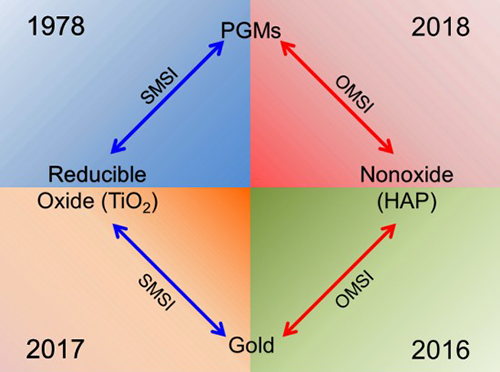A research group led by Prof. WANG Junhu, co-worked with Prof. ZHANG Tao and Prof. QIAO Botao's group from the Dalian Institute of Chemical Physics (DICP) of the Chinese Academy of Sciences, discovered the Strong Metal-Support Interaction (SMSI) between platinum group metals (Pt and Pd, PGMs) and hydroxyapatite (HAP). Their findings were published in Chemical Science.
The SMSI can change the morphology and electronic properties of metal nanoparticles, thus after the reactivity and selectivity, which are of important effect on the catalytic performance of supported catalyst. Also, it can generally stabilize the metal particles with embedding metal particles on the carriers, therewith stable metal catalysts can be prepared easily.

Schematic diagram on the development of SMSI researches. (Image by TANG Hailian and QIAO Botao)
The SMSI has been expanding since its discovery, but mainly focused on the PGMs catalysts supported on reducible metal oxides, and its reaction conditions are also limited to high temperature or ultra-high vacuum conditions for causing carrier reduction.
Based on the research experience of HAP supported metal catalysts, scientists discovered the SMSI between Au and HAP under oxidative atmosphere in previous studies. They designed and developed highly active & stable Au/HAP-TiO2 catalysts with unique semi-encapsulated nanostructure through tuning the O-SMSI, and systematically investigated the classical SMSI of oxide supported gold catalysts.
In this study, scientists discovered the O-SMSI existence between PGMs and HAP.
The PGMs nanoparticles were encapsulated by HAP carrier-like thin layer, and their aggregation growth and leaching among reaction process were effectively inhibited. Therefore, the reusability and reaction stability of the HAP-supported PGMs catalysts were markedly improved.
This study for the first time discovery that O-SMSI can occur in the PGMs catalysts, which provides a new way for the design and development of stable PGMs catalysts under oxidative environment.
PGMs loaded on reducible carriers such as titanium dioxide would lose their adsorption ability to small molecules (CO, H2) after high-temperature reduction, this phenomenon was coined by Tauster et al. in 1978 and named as SMSI (now referred as classical SMSI).
This work was financially supported by the National Natural Science Foundation of China, the Ministry of Science and Technology & the Chinese Academy of Sciences. (Text by TANG Hailian, QIAO Botao and Lucy)